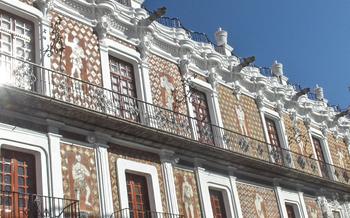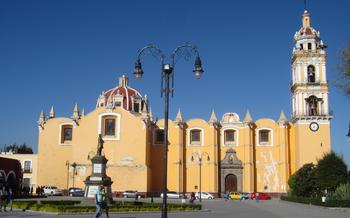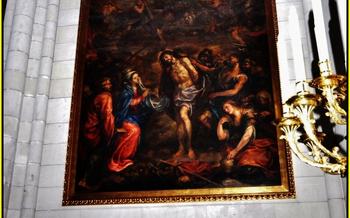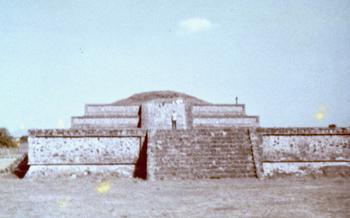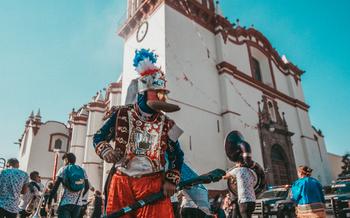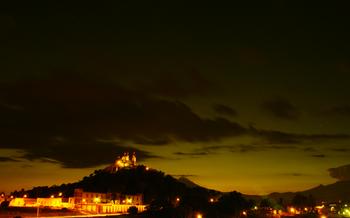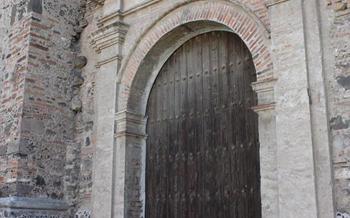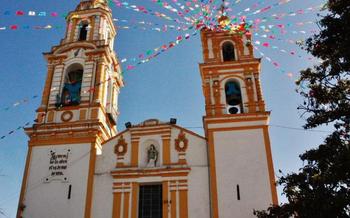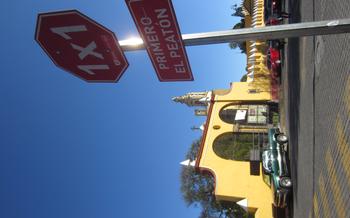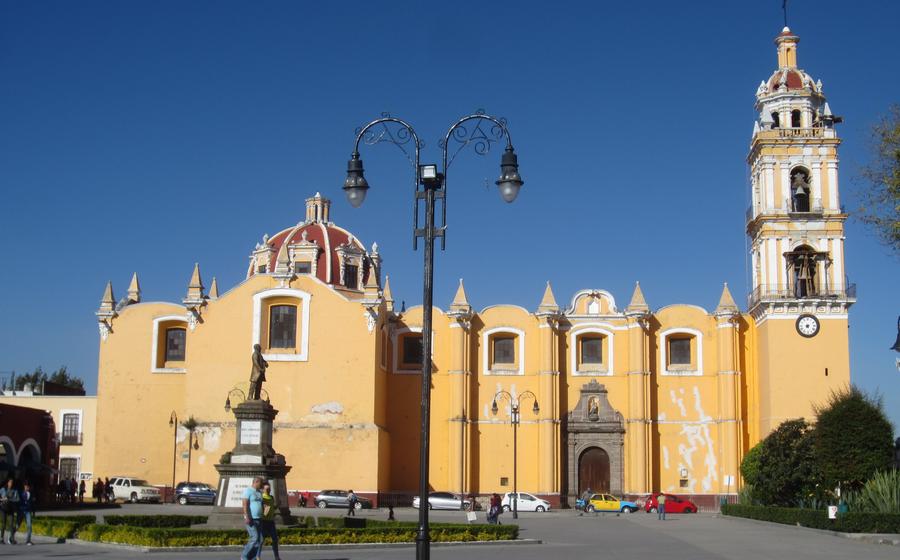
Templo de San Marcos Tlaxcalancingo
- A Journey to Cholula's Sacred Past
- Unveiling the Legend of San Marcos
- A Majestic Facade: A Blend of Styles
- Stepping Inside the Sacred Space
- The Captivating Altars: A Showcase of Faith
- A Glimpse into the Past: The Museum
- Pilgrimage and Festivities: A Time for Devotion
- A Haven for Art and Architecture Enthusiasts
- A Place of Peace and Reflection
- Beyond the Sacred Walls: Exploring Cholula
- Insider Tip: A Hidden Gem
A Journey to Cholula's Sacred Past
Cholula, a city nestled in the heart of Mexico, boasts a rich history dating back to pre-Hispanic times. As a significant ceremonial center, it was a place where indigenous beliefs and practices intertwined with the arrival of Catholicism. The Templo de San Marcos Tlaxcalancingo stands as a testament to this fusion, embodying the cultural and religious transformation that took place in the region.
The church's architectural style reflects the blending of indigenous and European influences, creating a unique and captivating structure. Its facade, adorned with intricate carvings and symbolism, hints at the stories and legends that lie within. Step inside, and you'll be awestruck by the grand dimensions, the intricate artwork, and the sacred atmosphere that envelops this sacred space.
The Templo de San Marcos Tlaxcalancingo is more than just a church; it's a journey through time, a place where the past and present converge, and where the fusion of cultures has created a masterpiece of faith and devotion.
Unveiling the Legend of San Marcos
The Templo de San Marcos is dedicated to San Marcos Evangelista, one of the four gospel writers. According to legend, San Marcos was a scribe and notary who traveled extensively, spreading the word of Jesus. He is often depicted with a pen in his hand and a book by his side, symbolizing his role as a recorder and transmitter of knowledge.
In Cholula, San Marcos is particularly revered as the patron saint of scribes, notaries, and merchants. Many locals who work in these professions visit the church to seek his blessing and guidance. Miraculous events are often attributed to San Marcos' intercession, and his devotees believe that he helps them in their daily lives.
The annual feast of San Marcos, celebrated on April 25th, is a major event in Cholula. During this time, the city comes alive with vibrant celebrations, processions, traditional dances, and music. The church is decorated with colorful banners and flowers, and a special mass is held in honor of the saint. Pilgrims from all over the region flock to Cholula to pay homage to San Marcos, creating a palpable sense of community and spiritual connection.
A Majestic Facade: A Blend of Styles
The facade of the Templo de San Marcos Tlaxcalancingo is a breathtaking blend of Baroque and Renaissance influences. Its grandeur and intricate details are a testament to the skill and artistry of the builders. The facade is adorned with ornate carvings, sculptures, and reliefs that depict religious scenes and symbols. The main entrance is particularly noteworthy, with its elaborate archway and decorative columns. The facade's overall design is a harmonious fusion of European and indigenous elements, reflecting the rich cultural heritage of Cholula.
Stepping Inside the Sacred Space
The interior of the Templo de San Marcos Tlaxcalancingo is a testament to the grandeur of Baroque architecture and the devotion of its builders. As you step inside, you are greeted by a sense of awe and wonder. The central nave, with its soaring arches and intricate ceiling frescoes, draws your gaze upward. The intricate artwork and religious iconography that adorn the walls and altars tell stories of faith, devotion, and the lives of the saints.
The main altar, a masterpiece of Baroque craftsmanship, is dedicated to San Marcos himself. Its intricate carvings, gold leaf accents, and vibrant colors create a mesmerizing spectacle. Smaller side altars, each dedicated to a different saint, line the nave, showcasing a diverse array of artistic styles and iconography.
The church's interior is a treasure trove of religious art and symbolism. Every detail, from the intricately carved choir stalls to the delicate stained glass windows, has been carefully considered and executed to inspire devotion and awe in the hearts of the faithful.
The Captivating Altars: A Showcase of Faith
Within the sacred walls of the Templo de San Marcos Tlaxcalancingo, a mesmerizing array of altars awaits the faithful and the curious alike. The main altar, a masterpiece of devotion, takes center stage, dedicated to the revered San Marcos Evangelista. Its intricate carvings, radiant colors, and intricate details narrate the saint's life and miracles, evoking a sense of awe and reverence.
Smaller side altars, each adorned with meticulous artistry, pay homage to other celestial figures. The Altar of the Virgin Mary, resplendent in shades of blue and gold, exudes an aura of grace and compassion. The Altar of the Sacred Heart of Jesus, with its crimson hues and intricate flourishes, symbolizes divine love and sacrifice.
The symbolism imbued in these altars extends beyond mere decoration. Every element, from the choice of colors to the arrangement of figures, holds deep spiritual significance. The use of precious materials, such as gold leaf and silver, underscores the sacredness of these spaces. The craftsmanship, honed over generations, reflects the deep devotion of the local artisans who poured their hearts and souls into creating these masterpieces.
Together, these altars form a captivating ensemble, inviting visitors to contemplate the lives and teachings of the saints, to seek divine guidance and inspiration, and to marvel at the enduring power of faith.
A Glimpse into the Past: The Museum
Within the grounds of buffs and culture enthusiasts alike—the on-site museum. Here, time seems to stand still as visitors embark on a journey through the annals of Cholula's rich past.
The museum houses a captivating collection of pre-Hispanic artifacts, meticulously curated to showcase the region's ancient heritage. These relics, unearthed from archaeological excavations and local sites, provide a tangible link to the vibrant civilizations that once thrived in this sacred land.
Exhibits within the museum tell the story of Cholula's evolution, from its pre-Columbian roots to its transformation under Spanish rule. Interactive displays and educational resources bring history to life, inviting visitors to engage with the past in a meaningful way.
Through the museum's exhibits, visitors gain insights into the artistry, craftsmanship, and religious beliefs of Cholula's indigenous inhabitants. They witness the fusion of cultures that occurred during the colonial era, as European influences intertwined with deep-rooted traditions.
The museum at the Templo de San Marcos Tlaxcalancingo stands as a testament to the enduring legacy of Cholula. It is a place where visitors can delve into the depths of history, uncover forgotten stories, and appreciate the enduring cultural heritage of this extraordinary region.
Pilgrimage and Festivities: A Time for Devotion
Each year, the Templo de San Marcos becomes a focal point of pilgrimage for devout believers who seek spiritual renewal and blessings. The annual pilgrimage to the church is a spectacle of faith and devotion, drawing thousands of pilgrims from near and far. During this special time, the church is adorned with vibrant decorations, and the atmosphere is filled with prayers, chants, and the scent of incense.
The feast of San Marcos, celebrated on April 25th, is a major event in Cholula, marked by vibrant celebrations that honor the patron saint. The streets come alive with music, dance, and colorful processions, as locals and visitors alike gather to pay homage to San Marcos. Traditional dances, such as the Danza de los Quetzales, are performed, showcasing the rich cultural heritage of the region. The air is filled with joy, laughter, and the sense of community that binds the people of Cholula together.
A Haven for Art and Architecture Enthusiasts
The Templo de San Marcos Tlaxcalancingo is a masterpiece of colonial architecture, blending indigenous and European styles in a harmonious ensemble. Its facade, adorned with intricate carvings and elaborate imagery, showcases the Baroque and Renaissance influences that shaped its design. The church's interior is equally captivating, with its soaring nave, ornate altarpieces, and stunning artwork.
Art enthusiasts will be in awe of the church's intricate murals, sculptures, and paintings. The main altar, dedicated to San Marcos, is a testament to the skill and craftsmanship of the artisans who created it. The side altars, each dedicated to a different saint, are equally impressive, showcasing a variety of artistic styles and techniques.
For those interested in architecture, the Templo de San Marcos Tlaxcalancingo offers a unique opportunity to study and appreciate the fusion of indigenous and Spanish influences. The church's design incorporates elements from both cultures, creating a harmonious blend that is uniquely Mexican.
Whether you are an art enthusiast, an architecture buff, or simply someone who appreciates beauty, the Templo de San Marcos Tlaxcalancingo is a must-visit destination. It is a place where history, art, and faith come together to create a truly awe-inspiring experience.
A Place of Peace and Reflection
Stepping inside the Templo de San Marcos Tlaxcalancingo, one is immediately struck by a sense of serenity and tranquility. The soft light filtering through the stained-glass windows casts a warm glow on the interior, creating an atmosphere conducive to contemplation and prayer. The church's spacious layout and high ceilings contribute to a feeling of openness and expansiveness, inviting visitors to find a quiet corner to sit, reflect, and connect with their spiritual side.
The church is a popular destination for pilgrims and religious seekers who come to seek solace, offer prayers, and find inner peace. The presence of numerous devotional objects, such as candles, statues, and offerings, adds to the sacred atmosphere of the space. Whether one is a devout believer or simply looking for a moment of respite from the bustling city, the Templo de San Marcos offers a sanctuary for spiritual reflection and tranquility.
Beyond the Sacred Walls: Exploring Cholula
Stepping outside the hallowed walls of the Templo de San Marcos Tlaxcalancingo, visitors find themselves immersed in the vibrant tapestry of Cholula. The city boasts a wealth of other historical sites that beckon exploration, each narrating a chapter in the region's rich past. From the awe-inspiring Great Pyramid of Cholula, the largest pyramid in the world by volume, to the charming colonial architecture that graces the streets, Cholula is a treasure trove for history buffs and architecture enthusiasts alike.
Beyond its historical allure, Cholula captivates visitors with its vibrant local markets, where the air buzzes with activity and the scent of delicious culinary delights wafts through the air. Shoppers can haggle for traditional handicrafts, savor the flavors of local cuisine, and immerse themselves in the warmth and hospitality of the Cholula people.
For those seeking a deeper cultural immersion, Cholula offers a plethora of opportunities to engage with the city's rich traditions. Visitors can witness traditional dances and music performances, participate in colorful processions, and immerse themselves in the vibrant fiestas that celebrate the city's patron saints. The annual pilgrimage to the Templo de San Marcos Tlaxcalancingo, drawing thousands of devotees, is a particularly captivating event, showcasing the deep-rooted faith and traditions of the region.
Insider Tip: A Hidden Gem
Beyond the confines of the Templo de San Marcos, Cholula holds a trove of hidden gems waiting to be discovered. One such gem is the Museo de la Talavera, a haven dedicated to the art of Talavera pottery, a unique and intricate ceramic tradition that has flourished in the region for centuries. Here, visitors can immerse themselves in the history, techniques, and exquisite designs of Talavera pottery, gaining an appreciation for the artistry and craftsmanship that goes into each piece. The museum's collection showcases a diverse array of Talavera ceramics, from traditional tiles to intricate decorative objects, providing a glimpse into the evolution of this vibrant art form. Whether you're an art enthusiast, a history buff, or simply curious about Mexican culture, the Museo de la Talavera offers a unique and enriching experience, inviting you to delve deeper into the rich tapestry of Cholula's heritage.
